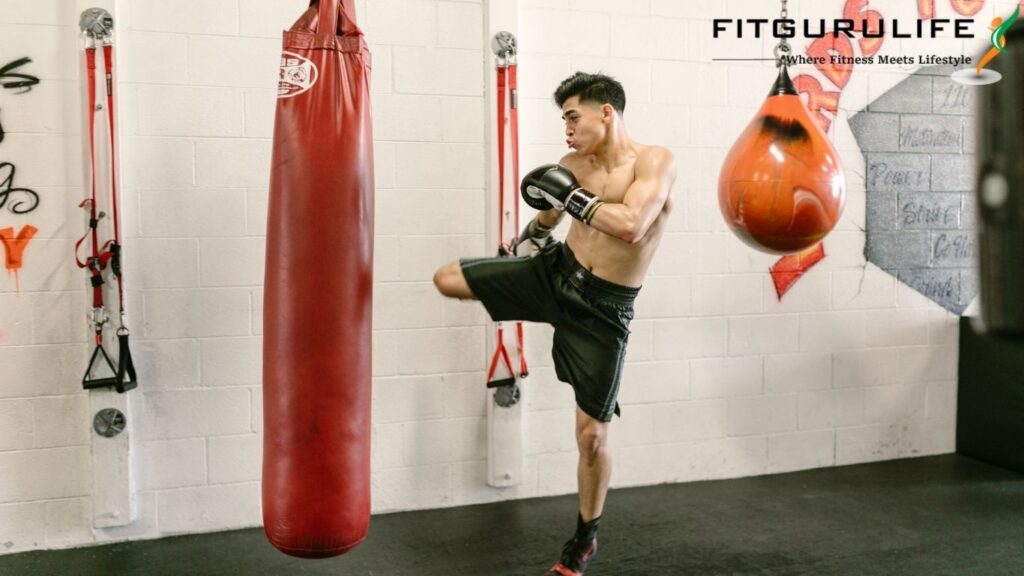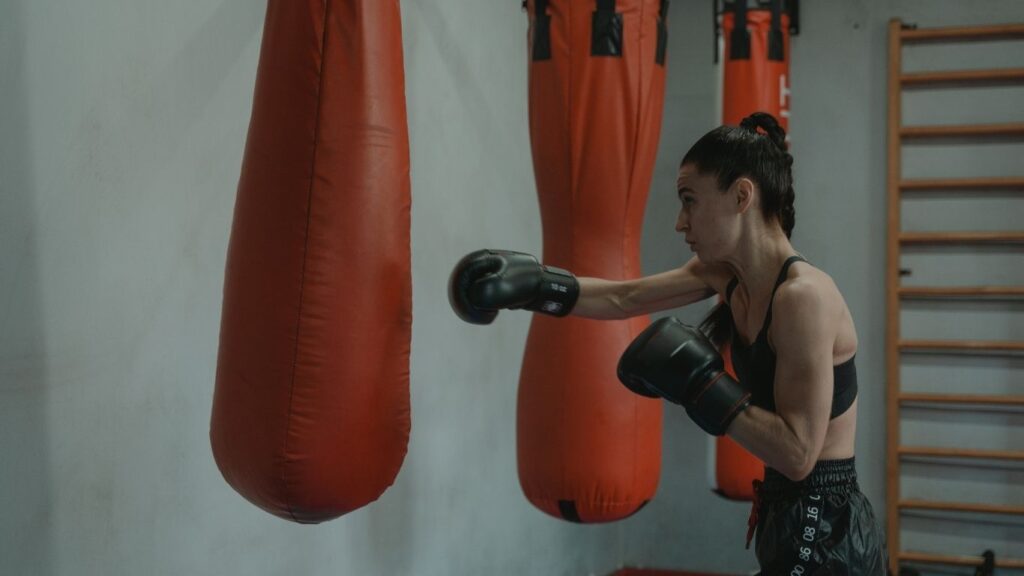Kickboxing, a dynamic and versatile martial art, has surged in popularity over the years due to its numerous benefits that extend far beyond physical fitness. Have you ever considered kickboxing as a form of exercise? If not, you’re missing out! Kickboxing is a high-intensity workout that combines martial arts techniques with fast-paced cardio, making it a fun and effective way to improve your fitness, burn calories, and learn self-defense. The best part is, you can do it from the comfort of your own home with minimal equipment. In this blog post, we’ll guide you through everything you need to know to get started with kickboxing at home.
Before we dive into the workouts, let’s cover the basics. Here’s what you’ll need to get started with kickboxing at home:
- Comfortable workout clothes
- A pair of supportive shoes
- A yoga mat or soft surface to protect your joints
- A timer or stopwatch
- A water bottle to stay hydrated
Once you’ve gathered your gear, you’re ready to start kicking and punching your way to a fitter, healthier you!
The Warm-Up
As with any workout, it’s essential to start with a warm-up to prepare your body for the exercises ahead and reduce the risk of injury. For your kickboxing warm-up, start with five minutes of light cardio, such as jogging in place, jumping jacks, or high knees. Once your heart rate is up, spend another five minutes doing dynamic stretching, such as leg swings, arm circles, and torso twists.
The Workout
Now that you’re warmed up, it’s time to start the workout! We’ve put together a 45-minute kickboxing routine that will work your entire body and get your heart pumping. Each exercise should be performed for 45 seconds, followed by 15 seconds of rest. Repeat the entire circuit three times, with a one-minute break between rounds.
- Jab-Cross Combo: Stand in a fighting stance with your left foot forward and your hands up in a guard position. Throw a jab with your left hand, followed by a cross with your right hand. Return to your guard position and repeat.
- Front Kick: Stand in a fighting stance with your left foot forward and your hands up in a guard position. Lift your right knee and then extend your leg to perform a front kick. Return to your starting position and repeat.
- Roundhouse Kick: Stand in a fighting stance with your left foot forward and your hands up in a guard position. Pivot on your left foot and swing your right leg in a circular motion to perform a roundhouse kick. Return to your starting position and repeat.
- Side Kick: Stand in a fighting stance with your left foot forward and your hands up in a guard position. Lift your right knee and then extend your leg to perform a side kick. Return to your starting position and repeat.

- Hook-Uppercut Combo: Stand in a fighting stance with your left foot forward and your hands up in a guard position. Throw a hook with your left hand, followed by an uppercut with your right hand. Return to your guard position and repeat.
- Knee Strike: Stand in a fighting stance with your left foot forward and your hands up in a guard position. Lift your right knee and drive it forward to perform a knee strike. Return to your starting position and repeat.
- Back Kick: Stand in a fighting stance with your left foot forward and your hands up in a guard position. Lift your right knee and then extend your leg to perform a back kick. Return to your starting position and repeat.
- Push Kick: Stand in a fighting stance with your left foot forward and your hands up in a guard position. Lift your right knee and then extend your leg to perform a push kick. Return to your starting position and repeat.
- Superman Punch: Stand in a fighting stance with your left foot forward and your hands up in a guard position. Jump up and throw a punch with your right hand, extending your left leg behind you like Superman. Return to your starting position and repeat.
- Sprawl: Stand in a fighting stance with your left foot forward and your hands up in a guard position. Drop to the ground in a plank position, then jump your feet back to your starting position. Stand up and repeat.
The Cool Down
After you’ve completed the workout, it’s time to cool down. Spend five minutes doing light cardio, such as walking or jogging in place, followed by another five minutes of static stretching. Focus on stretching your legs, hips, back, and shoulders, holding each stretch for 20-30 seconds.
The ways it shapes your overall development:

Stress Relief:
- One of the most notable benefits of kickboxing is its ability to alleviate stress. Engaging in a high-energy kickboxing session allows individuals to release endorphins, the body’s natural mood lifters. This physical exertion acts as an outlet for pent-up stress and can significantly improve one’s mental well-being.
- The rhythmic nature of kickboxing also aids in focusing the mind and achieving a state of flow, where worries and anxieties can dissipate, and the mind can experience clarity and calm.
Self-Defense:
- Kickboxing is rooted in martial arts, and its techniques are highly applicable to real-life self-defense situations. By learning various kicks, punches, and blocks, individuals can develop the skills necessary to defend themselves in case of an attack.
- The self-defense aspect of kickboxing not only empowers individuals but also enhances their awareness of their surroundings and improves their reflexes, contributing to a heightened sense of safety.
Cardiovascular Fitness:
- Kickboxing is an excellent form of cardiovascular exercise that helps to improve heart health. The combination of aerobic and anaerobic exercises within a single session boosts the heart rate and enhances lung capacity, ultimately leading to better cardiovascular fitness.
- Consistent practice of kickboxing can help regulate blood pressure, reduce the risk of heart disease, and improve overall endurance and stamina.
Weight Loss and Muscle Toning:
- Kickboxing is an effective way to burn calories and shed excess weight. A typical hour-long session can burn up to 750 calories, depending on the intensity and the individual’s weight.
- Besides weight loss, kickboxing also helps tone various muscle groups, including the legs, arms, core, and back. The explosive movements and high-intensity drills sculpt lean muscles and improve overall body composition.
Flexibility and Balance:
- The dynamic movements involved in kickboxing, such as kicks and stretches, help improve flexibility. Better flexibility reduces the risk of injuries and enhances the range of motion, making daily activities easier and more enjoyable.
- Additionally, kickboxing requires proper balance and coordination. Regular practice helps individuals develop a stronger sense of balance, ultimately improving posture and overall body control.
Social Interaction:
- Joining a kickboxing class can be a great way to meet new people and build a sense of community. Training with like-minded individuals who share similar fitness goals can be motivating and foster a supportive environment that contributes to one’s success.
- The social aspect of kickboxing also adds an element of fun and enjoyment, making it a sustainable and enjoyable form of exercise.
Enhanced Confidence:
- Learning the techniques and skills involved in kickboxing can significantly boost one’s confidence. Mastering new moves and gradually improving fitness levels contribute to a sense of accomplishment and self-efficacy.
- This newfound confidence often transcends the gym or dojo and permeates other areas of one’s life, including work, relationships, and personal endeavors.

Conclusion:
Kickboxing is an excellent way to improve your fitness, burn calories, and learn self-defense, all from the comfort of your own home. With this 45-minute routine, you’ll work your entire body and get your heart pumping. Remember to start with a warm-up, practice proper form, and finish with a cool down to reduce the risk of injury. Happy kickboxing!
Also read: Unveiling the Power of Morning Workouts: Stories of Real Motivation and Successhttps://fitgurulife.com/2023/10/26/unveiling-the-power-of-morning-workouts-stories-of-real-motivation-and-success/
